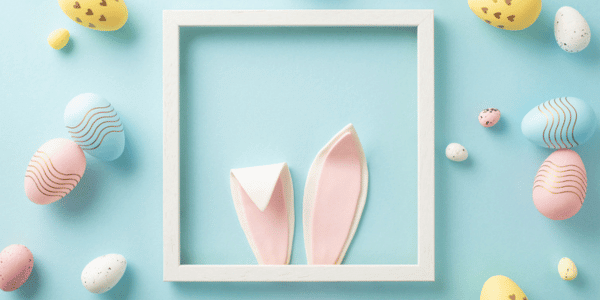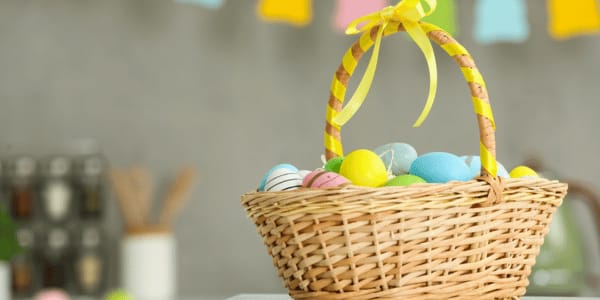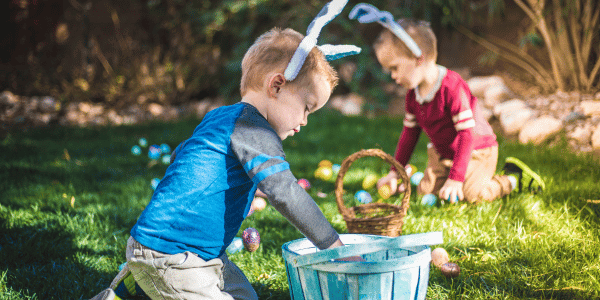The Surprising History of the Easter Bunny

You know the Easter bunny—the cute white rabbit with soft, fuzzy fur and cotton-ball tail. Hopping his way around town, he’s spotted at festivals, shopping malls, and Easter celebrations every spring. Although loved by all, the origin of the Easter Bunny remains a mystery, until now. Read on to learn about the history of the Easter Bunny, Easter Bunny traditions spread across the world, and ways to celebrate the Easter Bunny today.
The History of the Easter Bunny
Easter Bunny history dates back to medieval times. Ēostre (Ostara in Old German) is the goddess of spring whose name inspired the Easter holiday in Germanic cultures. It’s believed that she was a fertility goddess whose sacred animal was a hare. According to German lore, Ēostre freed a frozen bird from a tree by magically transforming it into a hare. While now a rabbit, it continues to lay eggs at Eastertime in honor of Ēostre.
The tradition of the Osterhase, or Easter Hare, is based on this folklore. Originating in Germany in the 17th century, the Easter Hare would lay eggs and deliver them to good boys and girls.
Where Did the Easter Bunny Come From?
German immigrants brought the Easter Bunny tradition to America in the 18th century. First celebrated in the Pennsylvania Dutch region, it quickly gained momentum and spread throughout the rest of the country. Children would build nests in hopes of receiving colorful eggs from him. Over time, the Easter Bunny not only delivered eggs, but also candy, toys, trinkets, and other surprises.
Today, the Easter Bunny—our smartly dressed, treat-delivering rabbit—has become a cherished symbol of Easter for children worldwide.
The Easter Rabbit in Different Cultures
Widely recognized in Western cultures, the Easter Bunny is a familiar figure in many households. You’ll find him in:
- The United States
- Canada
- Germany
- The United Kingdom
- Australia
- New Zealand
- Japan
Other countries have their own unique traditions: Switzerland celebrates the Easter Cuckoo, while Sweden marks the occasion with Easter witches.

Easter Bunny Activities
There’s no better way to celebrate the season than by taking part in an Easter Bunny activity. Every year, you’ll find the hare hard at work:
- Organizing Easter egg hunts. Usually held in a community park, the Easter Bunny hides candy-filled eggs to find and collect as many as they can.
- Dyeing Easter eggs. Raw eggs are dipped in food coloring and carefully laid out to dry, with tools like stencils and tape used to create unique designs.
- Building Easter baskets. Stuffed with a person’s favorite goodies, Easter baskets can include candy, chocolates, toys, socks, tees, and more.
Related: Spring Family Bucket List: Take Advantage of Spring with These Must-Dos
An Easter Recipe Every Bunny Will Love
The food du jour, eggs, are a must for any Easter menu. Quick, easy, and delicious, this recipe offers savory goodness in just two bites.
Dill Pickle Deviled Eggs
Serves 8
Ingredients
8 eggs
½ tsp yellow mustard
¼ cup mayonnaise
2 tsp dill pickle juice
¼ tsp salt
⅛ tsp black pepper
⅛ tsp garlic powder
2 baby dill pickles, finely diced
paprika (to taste)
4 slices bacon, cooked & crumbled
Directions
- Place eggs in a medium pot and cover with cold water. Bring to a boil, cover, and remove from heat. Let eggs sit in the covered water for 9-12 minutes.
- Drain water and immediately run cold water over eggs until cooled. Remove the outer shells, then cut the eggs in half lengthwise.
- Remove the yolks with a spoon and transfer to a mixing bowl. Arrange the egg whites on a serving platter and set aside.
- Using a fork, mash the yolks to a fine crumble. Add yellow mustard, mayonnaise, pickle juice, salt, pepper, garlic powder, and mash together until creamy.
- Mix in dill pickles and adjust seasonings to taste.
- Portion a generous teaspoon of the egg mixture into each egg white. Sprinkle with a light dusting of paprika and top with cooked bacon bits.
Fun Facts About the Easter Bunny
The Easter Bunny has entertained children of all ages for generations. Here are some fun facts about the Easter Bunny:
- The chocolate bunny dates back to 1800s Germany.
- While Easter is a Christian holiday, the Easter Bunny is a secular symbol.
- Rabbits represent fertility because of their high reproductive rates.
- Peeps marshmallows are the second most popular Easter treat, after chocolate.
- Every spring, more than 1.5 billion Peeps are consumed.

Building the Perfect Lawn for an Egg Hunt
An integral part of the Easter Bunny tradition includes a flawlessly executed Easter egg hunt, starting with a well-manicured lawn. To ensure your grass is in peak condition, check out “Mow Like a Pro: Grass Cutting Tips & Tricks.” You’ll discover how to keep your grass soft, green, and vibrant for the big day.